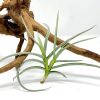hello@airplantplanet.com
₹365
Out of stock
Native distribution and habitat: The plant is native to Bolivia and south to
about 24 °south around Jujuy in NW Argentina at. It grows from 1,500 to 3,000
m in dry mountain valleys.
Growth habit: T. caliginosa is another ageotropic species with soft, thin, elegant,
grass like leaves. It is often identified by the new leafs folding out from one
another at the base but then twisting in various directions. Where the base of
the plant meets the stem the tissues are often a waxy green. The plant clumps
easily growing into a ball-shaped cluster.
Foliage: The leaves are about 150 mm long x 5 mm wide and festooned with
silver green trichomes that give the leaves a velvet appearance.
Flowers: The long thin flower spike (scape) begins to show in late summer and
takes months to fully form. As the flower buds form on the spike it can take on
a zig zag appearance. The species produces 2-3 yellow brown petaled flowers
on each spike which are fragrant and can be small or about 3 times larger than
T. crocata.
Pups: The off-set pups from on the stem below the mother plant
Cultivation: The plant responds to bright, airy conditions, keep on the dry side
Availability: The plant is not often available.

Out of stock